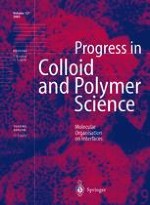2002 | OriginalPaper | Chapter
Solvatochromism in organized assemblies: effects of the sphere-to-rod micellar transition
Authors : Erika B. Tada, Omar A. El Seoud
Published in: Molecular Organisation on Interfaces
Publisher: Springer Berlin Heidelberg
Included in: Professional Book Archive
Activate our intelligent search to find suitable subject content or patents.
Select sections of text to find matching patents with Artificial Intelligence. powered by
Select sections of text to find additional relevant content using AI-assisted search. powered by
The solvatochromic behavior of 2,6-dichloro-4-(2,4,6-tri-phenyl-1-pyridinium-1-yl) phenolate (WB), 1-methyl-8-oxyquinolinium betaine (QB), and sodium 1-methyl-8-oxyquinolinium betaine-5-sulfo-nate (QBS) has been studied in the presence of spherical, and rod-shaped micelles of 1-hexadecyltrim-ethylammonium bromide (CTABr) and 1-hexadecylpyridinium bromide. Rod-shaped aggregates were obtained either by increasing the surfactant concentration or by adding NaBr, or a mixture of NaBr plus 1-decanol to the surfactant solution. The microscopic polarity of water at the solubilization site of the micelle-bound probe, ETmic, has been calculated from the position of its intramolecular charge-transfer band in the UV—vis region. The calculated polarities depend on the structure and charge of the probe, the additive present, but not on the surfactant headgroup (trimethylammonium, and pyridinium ion, respectively). Hydrophobic WB is solubilized in a relatively nonpolar microenvironment; its ETmic is only slightly dependent on the additive present. Anionic QBS behaves as a surfactant counterion, so it essentially reports the polarity changes that occur at the outer layer of the interfacial region. QB is sensitive to the presence of additives because they displace it to the outer part of the interfacial region. Our conclusions have been confirmed by measuring 1H NMR chemical shifts of the discrete hydrogen atoms of CTABr and QB. The “effective” water concentration at the probe solubilization site has been calculated from ETmic and solvatochromic data in bulk aqueous solvents, 1-propanol and 1,4-dioxane. Both solvent mixtures gave consistent concentrations of the effective water concentration at the probe solubilization site, except where preferential solvation of the probe (by one component of the binary mixture) is sizeable. The relevance of our data to micelle-mediated reactions is discussed.
